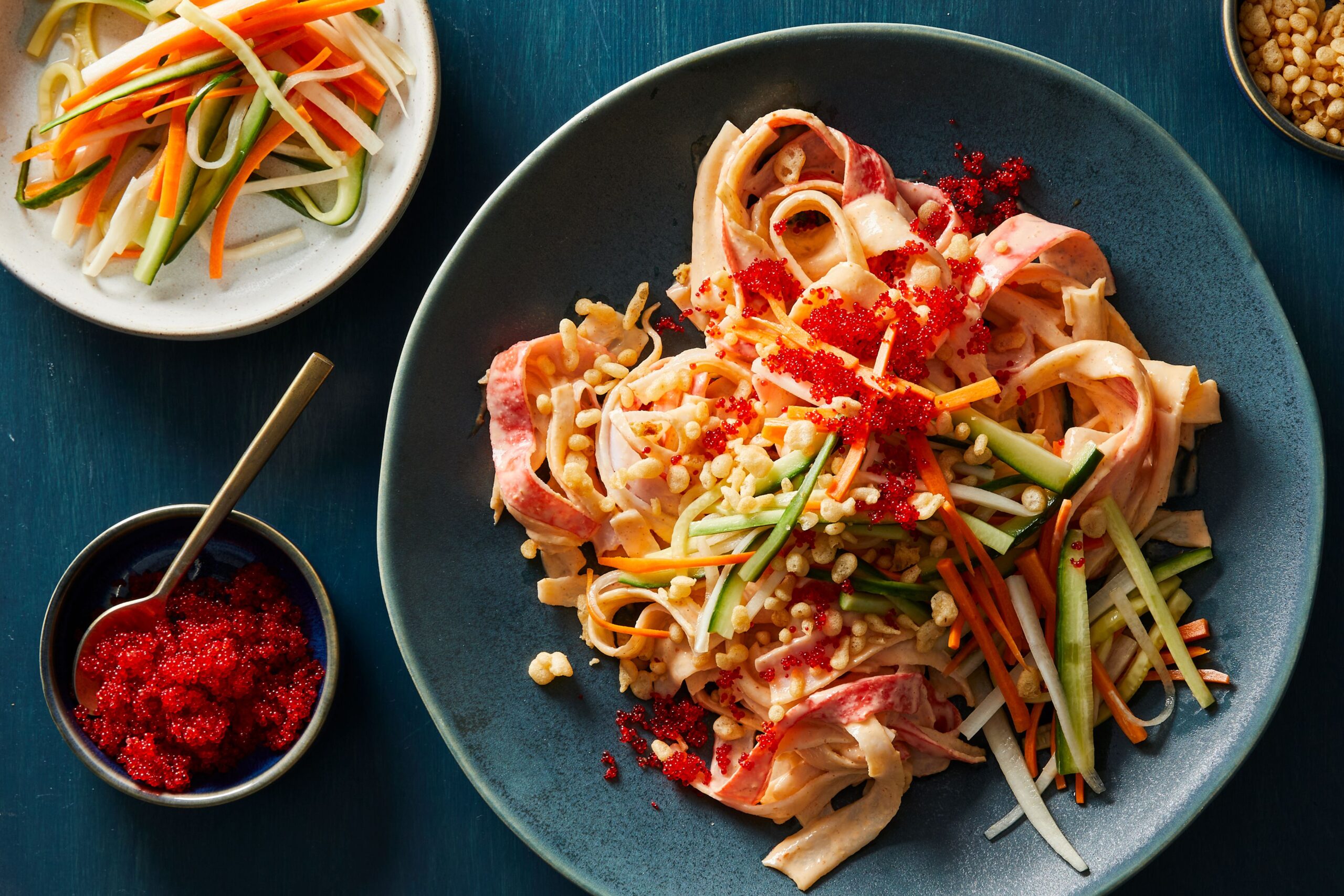Kani salad has become one of the most refreshing and delightful additions to healthy dining worldwide. This Japanese-inspired salad combines shredded crab sticks, crisp cucumbers, and creamy mayonnaise to create a flavorful, protein-packed dish. Loved by health-conscious eaters and food enthusiasts alike, kani salad strikes a perfect balance between taste and nutrition.
But what makes kani salad so good for you? In this guide, we’ll explore what kani salad is, its ingredients, calorie content, and — most importantly — the ten amazing health benefits that make this dish a must-try for your wellness routine.
Table of Contents
What Is Kani Salad?
Kani salad is a popular Japanese-style salad made primarily with kani (meaning crab in Japanese) or imitation crab sticks, cucumber, and a rich, creamy Japanese mayonnaise dressing. Sometimes, shredded carrots, mango, and sesame seeds are added to enhance its sweetness and texture.
Despite its Japanese origin, kani salad has gained worldwide popularity for its light and versatile nature. Whether enjoyed as a side dish or a refreshing lunch, it perfectly complements any healthy eating plan.
What Is Kani Salad Made Of?
Typical ingredients include:
- Imitation crab sticks (surimi)
- Cucumber (julienned)
- Carrots or mango (optional)
- Japanese mayonnaise
- Rice vinegar or lemon juice
- Sesame seeds or tobiko (fish roe) for garnish
These simple yet nutrient-rich components make kani salad both delicious and nourishing.
Nutritional Overview of Kani Salad
While kani salad tastes creamy and indulgent, it’s surprisingly light in calories. Here’s an approximate nutritional breakdown per one-cup serving:
| Nutrient | Amount |
|---|---|
| Calories | 140–180 kcal |
| Protein | 6–10 g |
| Fat | 9–12 g |
| Carbohydrates | 8–12 g |
| Fiber | 1–2 g |
| Sodium | 250–400 mg |
This balanced profile makes kani salad a great choice for dieters and fitness enthusiasts who want flavor without compromising on nutrition.
10 Amazing Health Benefits of Kani Salad
1. High in Protein
Kani salad contains a healthy dose of protein from imitation crab sticks. Protein supports muscle repair, tissue growth, and hormone balance. It also promotes satiety, keeping you full for longer and reducing unhealthy snacking. For anyone following a high-protein diet, kani salad makes an excellent light meal option.
2. Low in Calories
One of the standout benefits of kani salad is its low-calorie count. Each serving averages between 140–180 calories, depending on the dressing. This makes it an ideal addition for weight-conscious individuals who want to enjoy flavorful meals without excessive calorie intake.
3. Supports Heart Health
Kani salad, especially when prepared with authentic seafood or omega-3-rich imitation crab, can contribute to cardiovascular wellness. Omega-3 fatty acids help reduce triglycerides, lower blood pressure, and improve cholesterol balance. Adding sesame seeds or avocado as toppings can further enhance heart-protective benefits.
4. Rich in Vitamins and Minerals
Kani salad offers a variety of vitamins and minerals essential for daily health. Crab sticks contain vitamin B12, phosphorus, and selenium, which are vital for metabolism, bone health, and immune defense. Fresh vegetables like cucumber and carrots provide additional antioxidants and vitamin A for better skin and eye health.
5. Promotes Digestive Health
With its mix of fiber-rich vegetables, kani salad helps promote healthy digestion. The cucumber and carrots provide natural fiber that supports bowel regularity and improves gut microbiota. The vinegar or lemon juice often used in the dressing can also aid digestion and help balance stomach acidity.
6. Boosts Immunity
The nutrient-dense ingredients in kani salad — especially the combination of vitamins, selenium, and antioxidants — can strengthen your immune system. Regular consumption may help your body fight off infections, reduce inflammation, and improve your overall resistance to illness.
7. Hydrating and Refreshing
Cucumber, which forms the base of kani salad, is over 95% water. This makes the salad a great hydrating option for hot days or post-workout meals. Staying hydrated supports digestion, detoxification, and skin elasticity — making kani salad both tasty and rejuvenating.
8. Helps with Weight Management
Is kani salad good for diet? Absolutely. Its combination of lean protein, fiber, and minimal fat makes it an excellent choice for those managing their weight. It helps control hunger, maintains metabolism, and prevents overeating. Opting for light or yogurt-based dressing can make it even healthier.
9. Improves Skin and Hair Health
Thanks to its vitamin A, vitamin E, and omega-3 fatty acid content, kani salad supports radiant skin and healthy hair. These nutrients help reduce inflammation, promote collagen production, and prevent dryness or dullness caused by poor diet or dehydration.
10. Great for Mental Well-Being
A refreshing salad like kani salad can positively affect your mood and focus. Nutrient-dense meals high in omega-3s and B vitamins are known to reduce fatigue and enhance cognitive performance. The light, satisfying texture also contributes to a sense of calm and satisfaction.
Popular Variations of Kani Salad
Mango Kani Salad
This version adds fresh, ripe mango for a sweet and tangy twist. Mango boosts the salad’s vitamin C content, making it more beneficial for immunity and skin health.
Kani Salad Roll
A creative sushi-style adaptation, this roll wraps kani salad in seaweed with rice, offering a portable and balanced snack.
Spicy Kani Salad
Adding sriracha or chili flakes to the dressing creates a zesty version packed with metabolism-boosting capsaicin.
Each variation offers a different nutritional advantage, allowing you to enjoy kani salad in multiple healthy ways.
How to Make Kani Salad at Home
Ingredients
- 1 cup imitation crab sticks (shredded)
- 1 medium cucumber (julienned)
- ½ cup shredded mango or carrot
- 2 tablespoons Japanese mayonnaise
- 1 teaspoon rice vinegar or lemon juice
- 1 teaspoon sesame seeds or tobiko (for garnish)
Preparation
- Shred crab sticks, cucumber, and mango or carrots.
- Mix them in a large bowl.
- Add Japanese mayonnaise and vinegar; toss gently until coated.
- Garnish with sesame seeds or tobiko before serving.
Recommended Dressings
- Traditional Japanese Mayo: Rich, creamy, and slightly sweet.
- Sesame Dressing: Nutty and aromatic, offering healthy fats.
- Spicy Mayo: For those who enjoy a bit of heat with their salad.
Using lighter alternatives like Greek yogurt or low-fat mayo can reduce calories while maintaining flavor.
Tips to Make Your Kani Salad Healthier
- Use Fresh Ingredients: Crisp cucumbers and fresh crab sticks ensure better taste and nutrition.
- Control Dressing Portions: A small amount of mayo goes a long way — overuse adds unnecessary fat.
- Add More Vegetables: Include lettuce, bell peppers, or avocado for extra nutrients.
- Experiment with Toppings: Try chia seeds, flaxseeds, or roasted sesame for a healthy crunch.
- Choose Low-Sodium Crab Sticks: Reduces overall salt content for heart-friendly eating.
These simple tweaks can turn kani salad into a nutrient-dense, guilt-free dish for everyday meals.
Frequently Asked Questions (FAQs)
What is kani salad made of?
Kani salad is primarily made of imitation crab sticks (surimi), cucumber, and a creamy mayonnaise dressing. Some recipes include mango, carrots, or tobiko (fish roe) for added flavor and texture. The dressing is often Japanese mayo-based, sometimes mixed with rice vinegar or sesame oil.
Is kani salad good for diet?
Yes. Kani salad is low in calories and fat, yet high in protein and fiber, making it a great option for dieters. Choosing lighter dressing versions can make it even healthier without compromising on taste.
Where is the kani salad from?
Kani salad originated in Japan, inspired by traditional sushi ingredients. However, its popularity spread globally through Japanese restaurants and fusion cuisine. Today, it’s a staple in many Asian and Western menus alike.
How many calories are in kani salad?
One cup of kani salad typically contains between 140 and 180 calories, depending on the dressing used. The calorie count may rise slightly with additional ingredients like mango, avocado, or spicy mayo.
What dressing is used in kani salad?
Traditional kani salad uses Japanese mayonnaise, known for its rich umami flavor. Other popular variations include sesame dressing or spicy mayo. For a lighter version, Greek yogurt or vinaigrette can be substituted.
Can kani salad be made vegan?
Yes, by using plant-based crab substitutes and vegan mayonnaise, you can easily make kani salad vegan-friendly. Adding more vegetables like avocado and bell pepper enhances the texture and nutrition profile.
For more healthy recipe inspirations and meal ideas, visit My First Recipe — your go-to destination for nutritious and delicious dishes.
Final Thoughts
Kani salad is more than just a refreshing side dish — it’s a nutritional powerhouse filled with protein, vitamins, and antioxidants. Its light yet satisfying flavor makes it a perfect fit for healthy eaters, diet planners, and Japanese cuisine lovers.
Whether you enjoy it plain, spicy, or with a fruity twist, kani salad proves that healthy eating can also be delicious and exciting. Try preparing it at home with fresh ingredients for a wholesome, energizing meal.
For more health-related insights and wellness guides, check out our article on How Is Gloria Copeland Health?




